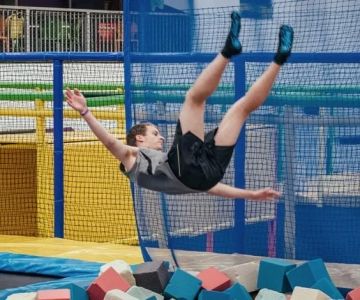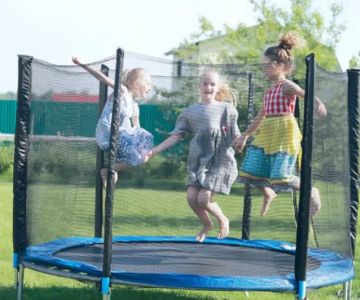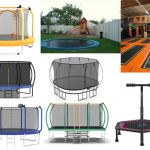- 1-Understanding-Anxiety-in-Children
- 2-Physical-Benefits-of-Trampolining-for-Anxiety
- 3-Sensory-and-Psychological-Effects-of-Trampoline-Use
- 4-Real-Life-Examples-and-Case-Studies
- 5-Practical-Tips-for-Using-Trampolines-for-Anxiety-Relief
1. Understanding Anxiety in Children
Anxiety in children can manifest as excessive worry, restlessness, and physical symptoms like stomach aches or headaches. It affects their daily life, school performance, and social interactions. Finding effective, child-friendly ways to manage anxiety is crucial for their overall development and well-being.
Physical activity has long been recognized as a valuable tool in anxiety management. Among these, trampolining offers unique advantages tailored to children's needs.
1.1 Why Physical Movement Matters
Movement helps regulate the nervous system by releasing endorphins—natural mood boosters—reducing stress hormones like cortisol, and improving sleep quality. Trampolining combines aerobic exercise with fun, making it an ideal option for kids.
2. Physical Benefits of Trampolining for Anxiety
Jumping on a trampoline provides cardiovascular exercise, enhances balance and coordination, and encourages body awareness—all of which contribute to lowering anxiety levels.
2.1 Cardiovascular Exercise and Mood Improvement
Regular trampoline use elevates heart rate and circulation, promoting the release of serotonin and dopamine, chemicals linked to happiness and relaxation.
2.2 Improved Sleep Patterns
Better physical fitness from trampolining can lead to more restful sleep, which is vital for emotional regulation and anxiety reduction.
3. Sensory and Psychological Effects of Trampoline Use
Beyond physical benefits, trampolines provide sensory stimulation that can soothe the nervous system. The rhythmic bouncing motion supports vestibular input, which helps children feel grounded and calm.
3.1 Boosting Confidence and Focus
Mastering trampoline skills fosters a sense of achievement and self-esteem. Additionally, the fun and engaging activity distracts from anxious thoughts, improving focus and mood.
3.2 Social Interaction Opportunities
Trampolines can encourage social play and bonding with peers or family, which strengthens support networks crucial for managing anxiety.
4. Real-Life Examples and Case Studies
Emma, a 9-year-old diagnosed with anxiety, showed remarkable improvement after incorporating daily trampoline sessions into her routine. Her parents noted reduced nervous behaviors and better sleep within weeks.
Schools and therapists have started including trampoline activities as part of sensory integration therapies, reporting positive outcomes in children’s emotional regulation.
5. Practical Tips for Using Trampolines for Anxiety Relief
To maximize benefits, ensure safety by using trampolines with proper enclosures and supervision. Start with short sessions and gradually increase duration based on the child’s comfort and energy levels.
Combine trampoline time with calming activities like deep breathing or mindfulness exercises to create a holistic anxiety management plan.
For quality trampolines and expert advice tailored to children’s mental health needs, visit Trampoline Zone, where you can find trusted products and support to enhance your child’s well-being.







 UPTOWN JUNGLE FUN PARK | Murrieta, CA4.0 (938 reviews)
UPTOWN JUNGLE FUN PARK | Murrieta, CA4.0 (938 reviews) Play and Spin3.0 (982 reviews)
Play and Spin3.0 (982 reviews) Xtreme Energy4.0 (203 reviews)
Xtreme Energy4.0 (203 reviews) Urban Air Trampoline and Adventure Park4.0 (1030 reviews)
Urban Air Trampoline and Adventure Park4.0 (1030 reviews) Urban Air Trampoline and Adventure Park4.0 (814 reviews)
Urban Air Trampoline and Adventure Park4.0 (814 reviews) Pat O'Rourke Recreation Center4.0 (204 reviews)
Pat O'Rourke Recreation Center4.0 (204 reviews) Are Trampoline Parks Safe for Kids? Essential Guide for U.S. Parents
Are Trampoline Parks Safe for Kids? Essential Guide for U.S. Parents How Often Should You Replace Trampoline Springs? Tips for Proper Maintenance
How Often Should You Replace Trampoline Springs? Tips for Proper Maintenance How Much Is a Trampoline? A Detailed Guide to Trampoline Costs and Buying Tips
How Much Is a Trampoline? A Detailed Guide to Trampoline Costs and Buying Tips Bounce Techniques for Stronger Legs: Effective Exercises and Tips
Bounce Techniques for Stronger Legs: Effective Exercises and Tips Essential Music Gear for Trampoline Dance: Complete Guide
Essential Music Gear for Trampoline Dance: Complete Guide Fun STEM Experiments Using Trampolines to Spark Curiosity and Learning
Fun STEM Experiments Using Trampolines to Spark Curiosity and Learning